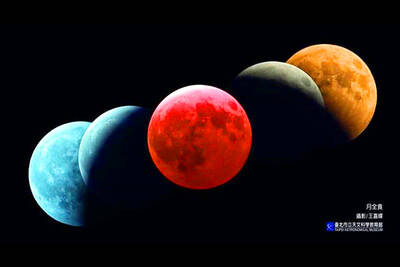While fried snacks are a popular choice for late-night supper, they could cause young children to be more susceptible to eye styes, a Shu-Tien Urology Ophthalmology Clinic doctor said yesterday, highlighting the case of a two-year-old girl who has repeatedly had the condition.
An eye stye is a small, painful lump on the inside or outside of the eyelid that is caused by a blocked oil gland.
Department of Ophthalmology director Yen Min-fang (顏敏芳) said the girl, surnamed Chen (陳), had suffered styes in both eyes multiple times, causing her eyelids to be red and swollen most of the time.
“Her parents said they often stay up late eating fried snacks or high-calorie pastries and their daughter always joins them,” the ophthalmologist said.
Yen said that while styes are mainly contingent on a person’s physical condition, unhealthy habits such as frequent eye rubbing, constant late nights and excessive consumption of deep-fried foods can increase the risk of the condition developing.
A large proportion of eye stye patients are aged from two to seven years old, with the youngest being about one year old, she said.
“Children today are addicted to foods that are high in fat, and the recent spate of tainted cooking oil scares have only raised more health concerns,” Yen said.
Unless parents take action to change their dietary habits that could overly stimulate sebum secretion, increasing the risk of styes, children will increasingly continue to suffer from the condition, she added.

Three batches of banana sauce imported from the Philippines were intercepted at the border after they were found to contain the banned industrial dye Orange G, the Food and Drug Administration (FDA) said yesterday. From today through Sept. 2 next year, all seasoning sauces from the Philippines are to be subject to the FDA’s strictest border inspection, meaning 100 percent testing for illegal dyes before entry is allowed, it said in a statement. Orange G is an industrial coloring agent that is not permitted for food use in Taiwan or internationally, said Cheng Wei-chih (鄭維智), head of the FDA’s Northern Center for

LOOKING NORTH: The base would enhance the military’s awareness of activities in the Bashi Channel, which China Coast Guard ships have been frequenting, an expert said The Philippine Navy on Thursday last week inaugurated a forward operating base in the country’s northern most province of Batanes, which at 185km from Taiwan would be strategically important in a military conflict in the Taiwan Strait. The Philippine Daily Inquirer quoted Northern Luzon Command Commander Lieutenant General Fernyl Buca as saying that the base in Mahatao would bolster the country’s northern defenses and response capabilities. The base is also a response to the “irregular presence this month of armed” of China Coast Guard vessels frequenting the Bashi Channel in the Luzon Strait just south of Taiwan, the paper reported, citing a

UNDER PRESSURE: The report cited numerous events that have happened this year to show increased coercion from China, such as military drills and legal threats The Chinese Communist Party (CCP) aims to reinforce its “one China” principle and the idea that Taiwan belongs to the People’s Republic of China by hosting celebratory events this year for the 80th anniversary of the end of World War II, the “retrocession” of Taiwan and the establishment of the UN, the Mainland Affairs Council (MAC) said in its latest report to the Legislative Yuan. Taking advantage of the significant anniversaries, Chinese officials are attempting to assert China’s sovereignty over Taiwan through interviews with international news media and cross-strait exchange events, the report said. Beijing intends to reinforce its “one China” principle

A total lunar eclipse, an astronomical event often referred to as a “blood moon,” would be visible to sky watchers in Taiwan starting just before midnight on Sunday night, the Taipei Astronomical Museum said. The phenomenon is also called “blood moon” due to the reddish-orange hue it takes on as the Earth passes directly between the sun and the moon, completely blocking direct sunlight from reaching the lunar surface. The only light is refracted by the Earth’s atmosphere, and its red wavelengths are bent toward the moon, illuminating it in a dramatic crimson light. Describing the event as the most important astronomical phenomenon